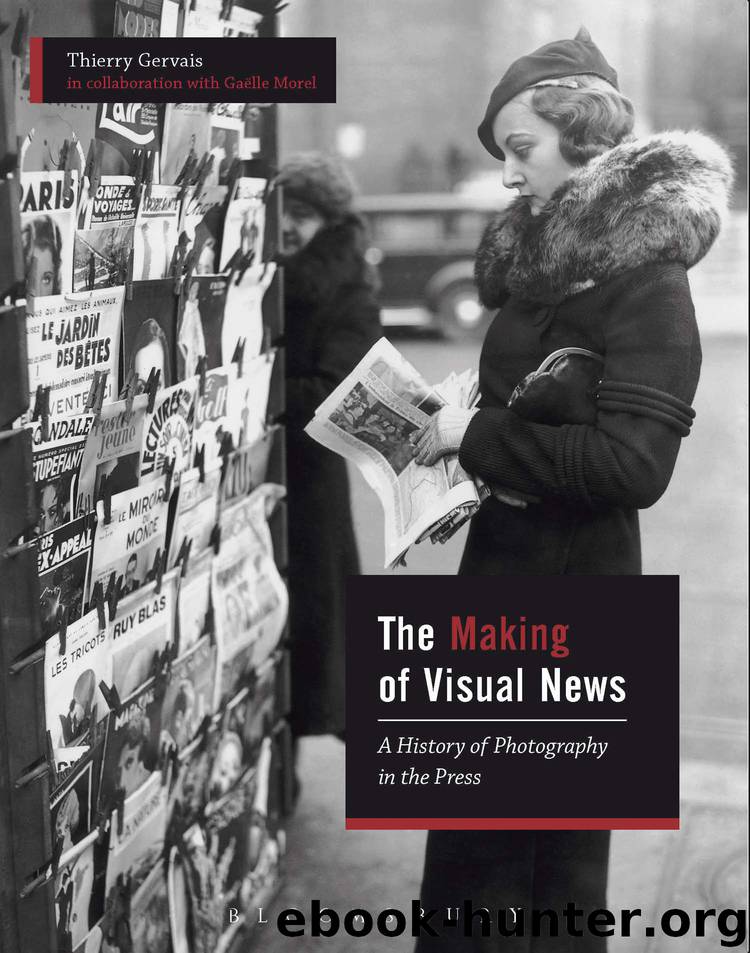The Making of Visual News: A History of Photography in the Press by Thierry Gervais

Author:Thierry Gervais
Language: eng
Format: epub
Publisher: Bloomsbury Publishing Plc
Published: 2017-05-19T04:00:00+00:00
Figure 3.5 Lilliput, August 1938, pp. 222–3.
Figure 3.6 Picture Post, November 12, 1938, pp. 30–1.
Lorant was assisted by Tom Hopkinson, whom he had met at The Weekly Illustrated, and two emigrant German photographers Felix H. Man and Kurt Hutton.42 In a format similar to Life’s, a typical 1939 issue of Picture Post comprised sixty pages, included over eighty photographs, and in structural terms reflected Lorant’s editorial experience.43 The table of contents was down-to-earth and contained only three sections: “Pictorial Features,” “Special Features” and “Articles.” The first two of these were devoted exclusively to photographic subjects, while “Articles” summarized the editorial material and the advertising, which were evenly distributed through the opening and closing pages of each issue, without ever interrupting the sequence of the photographic series. Lorant took charge of the selection and placement of the images, leaving Hopkinson to write the captions and texts comprising only a few paragraphs. While the “Articles” varied in length and could sometimes run to ten pages, the layout itself changed little and drew extensively on the graphic possibilities of the double page. As he had done at the Münchner Illustrierte Presse, Lorant arranged headings, text, captions and images symmetrically, with the binding as the vertical axis. In this constant search for equilibrium he used a range of formats to highlight the photographs he saw as making his point most effectively.
The first numbers of Picture Post covered the last maneuvers of the Spanish Civil War, notably with long series by Robert Capa. In the issue dated December 3, 1938 Lorant devoted eleven pages and a sequence of twenty-six photographs to the Republican attack on Franco’s positions along the Rio Segre. At a time when German and Italian military aid to Franco was intensifying, when international support for the Republicans was drying up, and when part of the International Brigades had been repatriated, the victory on the Rio Segre was a flicker of hope in the struggle against fascism.44 This reportage was first published in the French Communist magazine Regards, for which Capa had been working since the beginning of the conflict, then in Picture Post (see Figure 3.7), Life, and finally Match in December.45 Capa’s snapshots—of discussions of strategy, troop movements, shells bursting, soldiers cut down by bullets, stretcher-bearers aiding the fallen, care for the wounded behind the lines—were all numbered and captioned in sequence on the pages of Picture Post, whose layout stuck closely to the rules of symmetry so dear to Lorant. Moreover the images and captions were printed on a black background that made their ordering visually coherent. Tight shots of specific movements and concentrated faces, out-of-focus obstacles, camera shake caused by sudden movement or the impact of an explosion—all these factors, in the course of the series, guaranteed the presence and proximity of the photographer and, by extension, his journalistic credibility. In the title paragraph the editors are at pains to make it clear that the photographs “are not presented as propaganda for or against either side. They are simply a record of modern war seen from the inside.
Download
This site does not store any files on its server. We only index and link to content provided by other sites. Please contact the content providers to delete copyright contents if any and email us, we'll remove relevant links or contents immediately.
Shoot Sexy by Ryan Armbrust(17565)
Portrait Mastery in Black & White: Learn the Signature Style of a Legendary Photographer by Tim Kelly(16878)
Adobe Camera Raw For Digital Photographers Only by Rob Sheppard(16806)
Photographically Speaking: A Deeper Look at Creating Stronger Images (Eva Spring's Library) by David duChemin(16506)
Bombshells: Glamour Girls of a Lifetime by Sullivan Steve(13705)
Art Nude Photography Explained: How to Photograph and Understand Great Art Nude Images by Simon Walden(12859)
Perfect Rhythm by Jae(5082)
Pillow Thoughts by Courtney Peppernell(4034)
The Book of Joy by Dalai Lama(3712)
Good by S. Walden(3361)
The Pixar Touch by David A. Price(3226)
A Dictionary of Sociology by Unknown(2865)
Fantastic Beasts: The Crimes of Grindelwald by J. K. Rowling(2855)
Stacked Decks by The Rotenberg Collection(2700)
Humans of New York by Brandon Stanton(2695)
Read This If You Want to Take Great Photographs by Carroll Henry(2610)
On Photography by Susan Sontag(2495)
Photographic Guide to the Birds of Indonesia by Strange Morten;(2413)
Insomniac City by Bill Hayes(2406)
